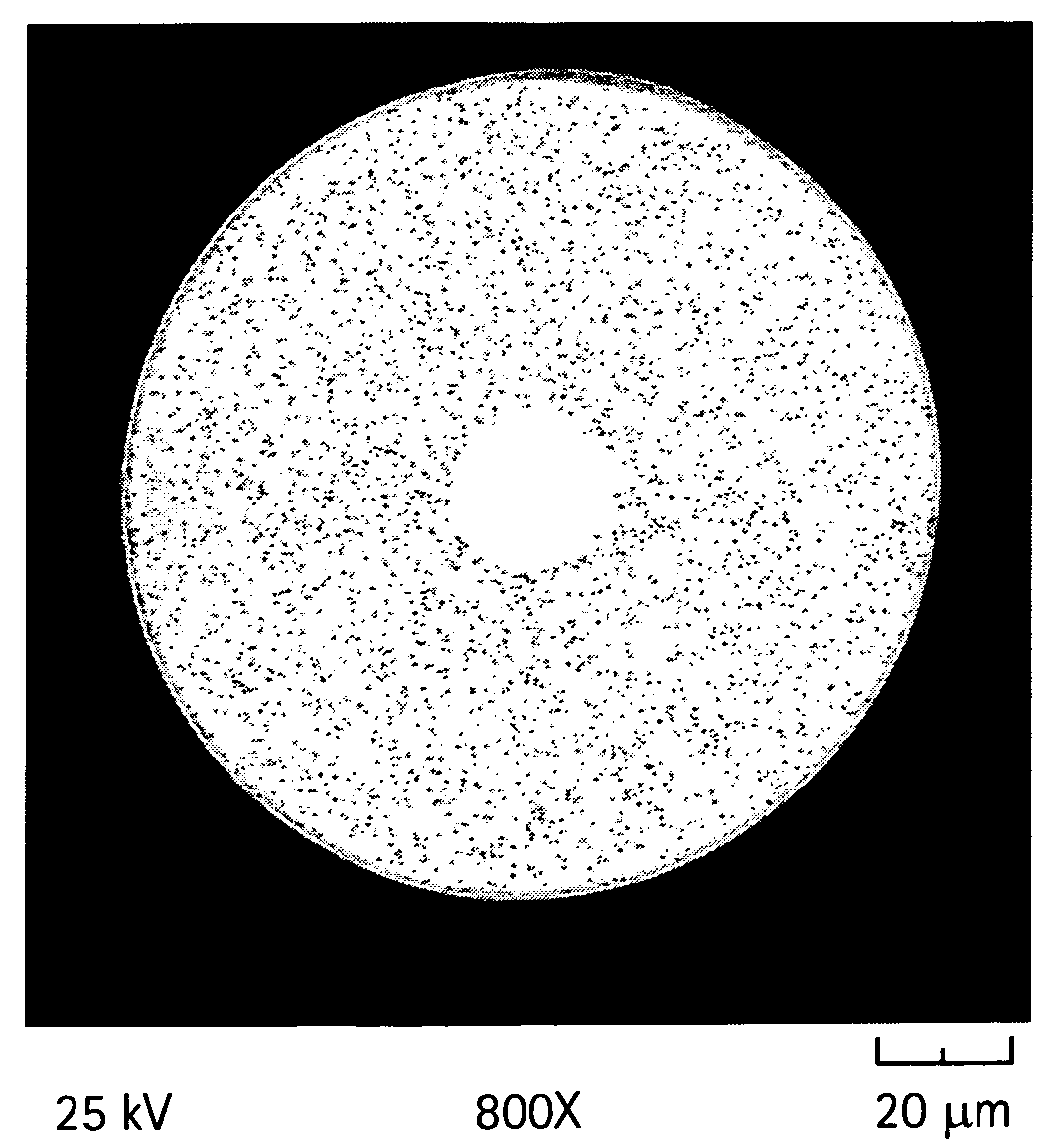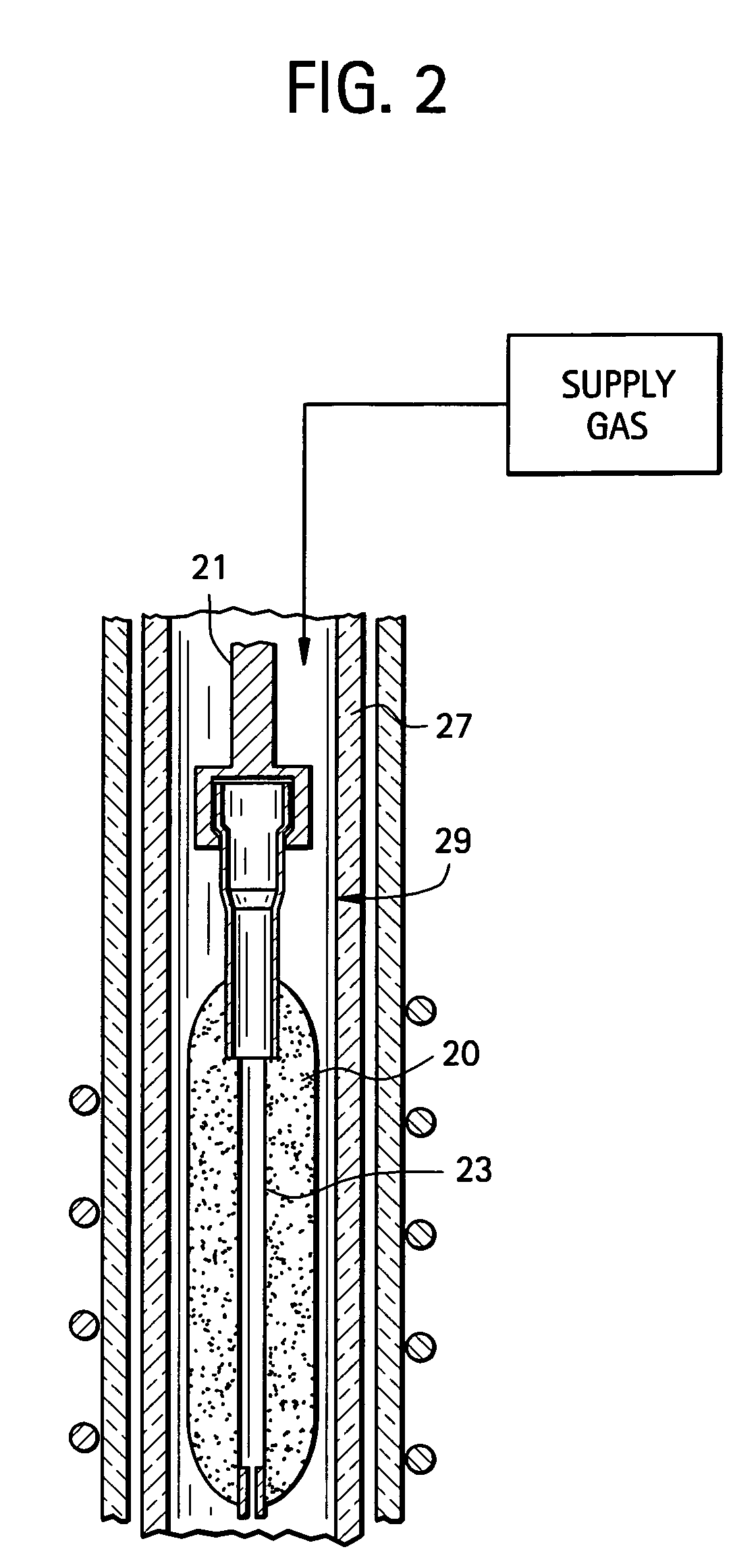Microstructured optical fibers and methods
a microstructured optical fiber and microstructure technology, applied in the field of optical fibers, to achieve the effects of improving the bend performance of optical fibers, reducing refractive index, and increasing attenuation
- Summary
- Abstract
- Description
- Claims
- Application Information
AI Technical Summary
Benefits of technology
Problems solved by technology
Method used
Image
Examples
example 1
[0051]3000 grams of SiO2 (0.48 g / cc density) soot were deposited using an outside vapor deposition process to form an SiO2 soot blank, i.e., by depositing onto a 1 meter long×10 mm diameter removable alumina bait rod. The alumina bait rod was removed and an 8 mm diameter core cane consisting of pure (undoped) consolidated silica was inserted into the SiO2 soot blank. This rod in soot assembly was then sintered as follows. The assembly was first dried for 2 hours in an atmosphere of 97 percent helium and 3 percent chlorine at 1000° C. followed by down driving at 32 mm / min (resulting in an increase in temperatures of the preform of approximately 16° C. / min.) through a hot zone set at 1500° C. in a 100 percent nitrogen sintering atmosphere. The preform assembly was than re-down driven (i.e., a second time) through the hot zone at 25 mm / min (approximately 12.5° C. / min. heat up rate of the preform), then final sintered at 6 mm / min (approximately 3° C. / min heat up rate) in order to sinter...
example 2
[0053]3000 grams of SiO2 (0.47 g / cc density) soot were flame deposited onto a 1 meter long×8 mm diameter pure silica core cane. This assembly was then sintered as follows. The assembly was first dried for 2 hours in an atmosphere consisting of helium and 3 percent chlorine at 1000° C. followed by down driving at 32 mm / min through a hot zone set at 1500° C. in a 70 percent nitrogen and 30 percent helium (by volume) atmosphere, then re-down driven through the hot zone at 25 mm / min, then final sintered at 6 mm / min, in order to sinter the soot to a nitrogen / helium-seeded overclad blank. The blank was placed for 24 hours in an argon purged holding oven set at 1000° C. to outgas the helium from the blank.
[0054]The blank was drawn to 125 micron diameter fiber in a manner similar to Example 1. SEM analysis of the end face of a fiber showed about 22 micron diameter solid silica core and a cladding containing 4.5 regional void area percent nitrogen filled voids with an average diameter of 0.4...
example 3
[0055]3000 grams of SiO2 (0.46 g / cc density) soot were flame deposited onto a 1 meter long×8 mm diameter pure silica core cane from Step 1. This assembly was then sintered as follows. The assembly was first dried for 2 hours in an atmosphere consisting of 3 percent chlorine gas, the remainder helium, at 1000° C. followed by down driving at 32 mm / min through a hot zone set at 1500° C. in a 50 percent nitrogen / 50 percent helium (by volume) atmosphere. The assembly was then re-down driven through the same hot zone at 25 mm / min, after which the assembly was re-down driven through the same hot zone for final sintering at 6 mm / min) in order to sinter the soot to a nitrogen / helium-seeded overclad blank. The blank was placed for 24 hours in an argon purged holding oven set at 1000° C. to outgas the helium from the preform blank.
[0056]The resultant optical fiber preform was drawn to 125 micron diameter fiber in a manner similar to Example 1. SEM analysis of the end face of a fiber showed a 2...
PUM
| Property | Measurement | Unit |
|---|---|---|
| diameter | aaaaa | aaaaa |
| diameter | aaaaa | aaaaa |
| diameter | aaaaa | aaaaa |
Abstract
Description
Claims
Application Information
 Login to View More
Login to View More - R&D
- Intellectual Property
- Life Sciences
- Materials
- Tech Scout
- Unparalleled Data Quality
- Higher Quality Content
- 60% Fewer Hallucinations
Browse by: Latest US Patents, China's latest patents, Technical Efficacy Thesaurus, Application Domain, Technology Topic, Popular Technical Reports.
© 2025 PatSnap. All rights reserved.Legal|Privacy policy|Modern Slavery Act Transparency Statement|Sitemap|About US| Contact US: help@patsnap.com



